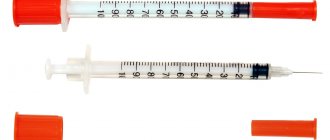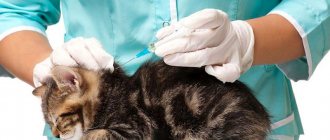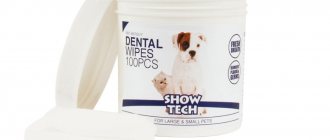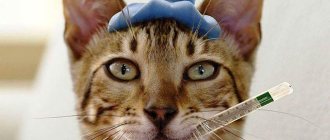A cat's normal body temperature is between 38 and 39 degrees (when measured rectally). A cat's body temperature is a comprehensive indicator of the body's thermal state. Cats are mammals, that is, they are warm-blooded, or homeothermic animals. This means that their body temperature normally fluctuates within very narrow limits, and any deviation beyond these limits (increase or decrease) will be a sign of various pathologies or adverse effects of the external environment. Body temperature is one of the most ancient ways of determining the current state of the body (the so-called biomarker).
What temperature should a cat be?
The most definitive way to tell if your cat has a fever is to take her temperature. A cat's normal body temperature is between 37.5 and 39.2 degrees Celsius. Temperatures above this range indicate fever
Ear thermometers are simpler and more convenient for pet owners, but as the Petcha website explains: “The best and most cost-effective way to take a cat's temperature is to use a pediatric rectal glass or digital thermometer. "Taking a cat's temperature at home requires two people: one to hold the cat and the other to insert the thermometer." Be sure to lubricate the thermometer with Vaseline and wait at least two minutes after inserting to get the most accurate result. Do not insert the rectal thermometer too deeply, as rectal tissue is sensitive and you may injure the animal. Also, never use a mercury thermometer because if it breaks, it can be very harmful to the cat's health and life.
While it's not the most attractive or convenient method, taking a rectal temperature is the best way to answer the question of whether your pet has a fever. If you are not comfortable doing this yourself, contact your veterinarian to have her temperature taken. It's also important to have your cat's vaccination records so your veterinarian can learn about any other diseases your pet may not have been vaccinated for to help narrow down the cause of her fever.
How to bring down or increase the temperature
If a cat's body temperature increases or decreases, in order to temporarily alleviate its physiological condition, it is possible, depending on the situation, to lower or increase the temperature.
Attention! There is no treatment for temperature as such; temperature is only a symptom indicating the presence of pathology in the animal’s body.
In order to bring down the temperature, you need to wrap the cat in a damp, cold towel, give it a cold drink (slightly below room temperature), put it in a cool place without drafts, but under no circumstances on a concrete floor or ground. If the temperature rises due to illness, it is necessary to urgently begin treatment for the disease and take a course of IV drips to reduce the temperature.
A pet with hyperthermia should never be given fever-reducing medications intended for humans.
First aid for fever is to wrap the animal in a cold, wet towel and take it to the clinic. Drinking water must be available at all times.
To increase the temperature, the cat must be placed on a warm heating pad, and bottles of warm water wrapped in a rag should be placed next to it (to prevent burns). Give a warm drink. If a decrease in temperature occurs against the background of a disease, immediately begin treatment and raise the temperature in a veterinary clinic.
First aid for a low temperature is to put the cat on a heating pad, give him warm water to drink and take him to the clinic.
Causes
If you believe your cat has a fever (or, to use the medical term, hyperthermia), your veterinarian will determine whether further testing is needed to determine the cause. Knowing the animal's medical history will be very helpful here. If you must see a different healthcare provider than one who already knows your pet, be sure to provide documentation of your pet's medical history, especially a list of medications, as cats sometimes have poor reactions to certain medications.
Just like in humans, there are many possible causes of fever in cats. The most common is a bacterial infection. Other likely causes are problems with the immune system or inflammation, exposure to toxins, a disorder or some kind of disease. It may be that the cause of your cat's fever cannot be determined, in which case you and your veterinarian can discuss next steps.
What help to provide
A common mistake is to give a cat antipyretics intended for humans. Under no circumstances should you do this! Before giving medicine to an animal, you should at least call your veterinarian and ask his advice.
You can try to alleviate your cat's condition using the following measures:
- ensure the room is ventilated;
- apply ice wrapped in a cloth or a damp towel to the groin to reduce the temperature a little;
- Place more water next to her bed.
If time passes and the condition does not improve, contact your veterinarian. If this cannot be done right away, then you need to:
- wipe the cat’s paws with a damp cloth once every half hour (but do not wet the fur!);
- if your pet has diarrhea or vomiting, he needs Regidron solution, replacing solid food with broth and more water.
Treatment
In addition to rest and drinking plenty of fluids, antibiotics are commonly used to treat fever in cats. Getting your cat to take medications, as well as taking his temperature, is not easy, but it is very important. If he spits out the pill or doesn't eat the cat food you hid it in, use these great tips on how to give pills to your pet. One of them is to wrap the animal in a towel for its comfort and safety. It would be nice to get an assistant to cope with this non-trivial task.
In some cases, your veterinarian may recommend a liquid medication for hyperthermia, which is easier to give.
It's not easy to watch your fur baby suffer from a fever, but beyond the medical care instructions your veterinarian has prescribed, there are some steps you can take to prevent the illness from developing. Regular cat care (brushing teeth, trimming nails) and periodic checkups (checking ears, monitoring her eating and drinking habits) will help lay an excellent foundation for a healthy life for your pet.
And don't forget to hug the cat. A little love will help your pet get better faster!
Heat stroke in a cat
Representatives of the cat family practically do not sweat in the heat. To feel more comfortable under the scorching sun, animals lick themselves more often, but this does not reduce the risk of heat stroke. There are few thermoreceptors on the skin of pets, so a short-term increase in temperature may go unnoticed.
Some types of cats are at risk of overheating more often than others - these are exotic breeds with a short muzzle, hairless and short-haired breeds, animals with cropped hair. Risk factors also include:
- being overweight;
- venerable age;
- chronic cardiovascular diseases, asthma, shortness of breath.
If your pet is initially at risk, do not forget to monitor its condition on hot days. Heatstroke in a cat that is regularly outdoors goes away more easily and quickly than in completely indoor pets. If an animal suffers from overheating, this will affect its well-being and behavior:
- the increase in temperature is noticeable to the touch;
- breathing quickens and becomes deeper;
- salivation increases;
- the nose becomes dry and hot;
- the mucous membranes on the gums turn pale or red;
- lethargy appears, stability of movements is lost;
- Possible nosebleeds.
If you notice some of these signs, you need to urgently take measures to alleviate the cat’s condition.
How to measure a cat's temperature
So, using a thermometer is the only reliable way to determine body temperature in animals. But which side to approach and how to measure a cat’s temperature?
There are 2 types of thermometers used for animals:
Ear thermometer
- Classic thermometer
- Ear
Classic thermometer
can be alcoholic or electronic. It is used rectally. You can measure a cat's temperature not rectally.
Ear thermometer
a more modern device, its use is less stressful.
How to take a cat's temperature rectally
- Have a helper help hold and calm your cat during the procedure. During temperature measurement, most pets behave calmly, but particularly temperamental cats may resist. It is better to entrust such animals to a veterinarian. An aggressive cat can cause harm to itself or its owner.
- Prepare a thermometer. It is better to use a veterinary or children's electronic thermometer. Measuring temperature with such a device is more comfortable and takes only 2-3 minutes.
- Wipe the tip with alcohol and lubricate it with Vaseline or Levomikol ointment.
- Raise your tail. Slowly, using a twisting motion, insert the thermometer into the anus to a depth of 2-3 cm. Hold the thermometer until the beep sounds.
- After the signal, do not rush to remove the thermometer. Make sure that the device works correctly and the numbers do not increase. On some models, the signal is triggered ahead of schedule and for an accurate result you need to hold the device in the rectum for another 20-40 seconds.
- Evaluate the measurement result and wipe the tip of the thermometer generously with an alcohol wipe.
How to Measure Temperature with an Ear Thermometer
- Calm the cat down. Let the thermometer sniff, show your pet that the device does not pose a danger. When measuring ear temperature, you can usually do without an assistant.
- Wipe the tip of the thermometer with an alcohol wipe.
- While supporting your pet's head, insert the thermometer into the ear canal. Most cats are indifferent to the procedure. Do not try to push the thermometer very deep, so as not to damage the eardrum.
- Wait for the beep and make sure the readings do not increase.
- Remove the thermometer from your ear and compare the result with the norm.
- Disinfect the thermometer tip again.
Symptomatic diet and procedures
If the temperature is high, then you can help your pet in the same way as a child. That is, apply cool, damp cloths to the main arteries (armpits, neck, inner thighs). Such procedures help well with banal overheating.
When the temperature rises, the animal should be given a lot to drink. Sometimes it is recommended to apply pieces of ice, but you need to be careful with this procedure.
If the temperature rises quickly and has reached high numbers, you should not apply ice. This may lead to seizures. In this case, the animal is prescribed special veterinary medications to reduce the temperature. In this case, the animal requires specific treatment.
In addition, it is worth remembering that a cat’s body becomes hypothermic just as quickly as it overheats. Therefore, you should not bathe your animal in a cold shower. You can't even pour cold water on it.
You can place your cat under a fan or air conditioner when his temperature is elevated. But again it is necessary to ensure that the pet does not become hypothermic.
An effective way is to use a weak vinegar solution. They lubricate the cat's pads about once an hour.
Echinacea tincture has also proven itself well. It is necessary to mix the tincture with water (at the rate of 1 drop per 1 kilogram of the cat’s weight) and give the pet this mixture.
A high body temperature in a cat is an unpleasant phenomenon, but there is no need to panic. It is necessary to observe the animal and try to reduce the temperature using folk methods. If the animal gets worse, it must be shown to a veterinarian.
What to do if you have hyperthermia
To relieve fever and stress after heatstroke, wrap your cat in a damp, cool cloth and hide him from the heat. Next, you need to measure your body temperature. The measurement is performed rectally, so cats do not like this procedure. The pet is sensitive to the state of the owner, so during the measurement it is necessary to behave as calmly as possible.
Secure the cat with a soft towel and carry out the necessary manipulations without fuss. We recommend using an electronic thermometer, which quickly provides readings on a convenient display. This will help speed up the process. An ordinary mercury thermometer will have to be held for several minutes until the exact result becomes known. After the measurement, call a veterinarian at home or take the cat to the clinic for an examination.
If you live in Kaliningrad or the region, you are welcome at the branches of the Kaliningrad Regional Center for Veterinary Medicine. The doctors at our clinic will help your pet quickly return to normal. At the appointment, the veterinarian will perform an examination, determine the cause of the ailment and prescribe appropriate treatment and care. Each branch has a pharmacy for animals, which has everything you need.
Contact us: our animal clinic in Kaliningrad has experienced veterinarians and qualified care for your pets. We create ideal conditions for the recovery of pets and are always ready to help.
Causes of high temperature
Fever in cats is not a disease. This is a symptom that signals that something is wrong in the animal’s body.
We are accustomed to the fact that when the temperature rises, the forehead becomes hot and chills appear. But such signs are typical for people. But in animals this symptom manifests itself differently.
Before you look for the reasons for the rise in temperature and worry, you need to know what temperature is considered normal for a pet.
The norm is:
- 38-39оС - for an adult cat;
- up to 41°C - for an adult sphinx;
- up to 39.6°C - for a kitten.
An increase in temperature in a cat is characterized by the following signs:
- Refusal to eat or minimal appetite.
- Lethargy, weakness, apathetic state.
- Increased breathing, tachycardia.
- Trembling, convulsions.
- The animal is trying to hide from its owner.
- Dehydration sets in.
- The animal behaves strangely, its state is close to shock.
- Dry and hot nose (by the way, immediately after sleep, a cat may have a dry and warm nose, this is normal, but very quickly it becomes wet and cool).
You should immediately contact a veterinarian if the following are observed against the background of fever:
- The cat's eyes water, sneezing and mucus appear from the nose.
- Vomiting, diarrhea, or bloody diarrhea.
- There are hemorrhages on the skin.
- Shortness of breath and wheezing appear.
- Bleeding from the intestines, in particular from the rectum, is observed.
- The eyes and mucous membranes of the mouth turn yellow.
The danger of raising the animal’s body temperature is that serious qualitative changes in the pet’s metabolism occur.
Blood circulation is disrupted (this is especially dangerous for animals with heart disease), and the rate of oxygen delivery to the brain changes.
The animal suffers from loss of moisture and salts, this can cause convulsive seizures or excessive agitation, depression and fainting.
The main signs of high temperature in an animal are:
When the body temperature is from 39.5°C to 40°C the animal does not feel well. He has all the symptoms described. The pet needs to be taken to the hospital. When the body temperature rises above 40.5°C, the animal begins to become dehydrated and the pet’s condition is depressed.
If the body temperature exceeds 41°C, dehydration reaches a critical level, the functioning of internal organs is seriously impaired, and diarrhea or vomiting occurs.
Brain swelling, intestinal bleeding, and failure of internal organs may begin (accompanied by jaundice, the appearance of an acetone odor from the pet’s mouth, and anuria).
This condition can result in the death of the animal.
Experts talk about the following reasons for increased body temperature in cats:
According to statistics, 40% of cases of fever in cats are due to infections, about 20% of cases are statistically allocated to oncological and systemic pathologies, and about 10% are various diseases, as well as idiopathic (that is, with an unknown cause) fever.
Viral diseases that are severe for cats, such as calcevirosis and rhinotracheitis, occur with a very high temperature and are accompanied by purulent conjunctivitis, rhinitis, and indigestion. They require mandatory treatment by a veterinarian.
Any viral, bacterial infections and even helminthic infestations can occur with an increase in the animal’s body temperature. In this case, the cat usually refuses food, and there may be vomiting or diarrhea.
A reaction to drugs or substances toxic to animals may be accompanied by a rise in temperature, but other symptoms usually come to the fore: vomiting blood, refusal to eat, bloody diarrhea.
Allergies in the skin form or in the form of allergic rhinitis, bronchial asthma can occur with an increase in body temperature. Usually the temperature does not rise to critical levels and the owner pays attention to the animal’s coughing, sneezing, lacrimation and discharge of clear contents from the nose. Allergic pneumonitis can be accompanied by high fever, a specific cough, and a serious disturbance in the general condition of the pet.
Endocrine disorders are often accompanied by impaired thermoregulation of the animal. In this case, the temperature usually rises moderately. The animal's body weight changes significantly (obesity develops or the cat loses a lot of weight), the mood changes, the cat may be depressed, the animal may urinate or drink frequently, the quality of the coat may deteriorate, and baldness may begin. Tumors often develop against the background of hormonal imbalances.
An increase in general body temperature may be accompanied by post-injection or post-injection abscesses and mastitis in cats. In this case, the site of abscess formation is usually visible: a painful swelling.
Hyperthermia in cats can be due to simple overheating. During the hot season or if the owners heat the living space too much in winter, the cat may overheat. In this case, the animal breathes intensely and may have tachycardia. The cat cools itself with the help of nasal breathing, so the animal’s breathing quickens, it tries to more actively remove heat.
Body temperature in cats may increase during estrus. At the same time, the animal shows all the signs of “need for a cat.” Constantly meows, puts the croup down, and becomes depressed if her needs are not met.
Growing neoplasms, especially during the period of necrotization and tissue decay, are accompanied by an increase in temperature. At the same time, the animal actively loses body weight, its fur deteriorates, and digestive processes are disrupted. The cat may refuse food.
Cats may have neurogenic fever. That is, after stress (when moving, changing owner, and similar situations), the animal’s body temperature may rise; its peculiarity is that antipyretic drugs are ineffective in this case. This temperature is accompanied by a disturbance in the animal’s mood, but quickly passes when the animal calms down.
How to tell if a cat has a fever
Today, the only accurate method to understand that a cat has a temperature is to use a thermometer. However, there are several signs that indicate your cat is not feeling well.
- Lethargic or inappropriate behavior
- Loss of appetite
- Increased thirst
- Rapid or, conversely, infrequent breathing
It is impossible to accurately determine elevated body temperature “by the nose”! Of course, a healthy cat's nose should be cold and damp, but only an active cat under ideal conditions. The humidity of the nose and its local temperature are influenced by the pet's activity, nervous excitement, desire to drink and eat, and environmental climate.











